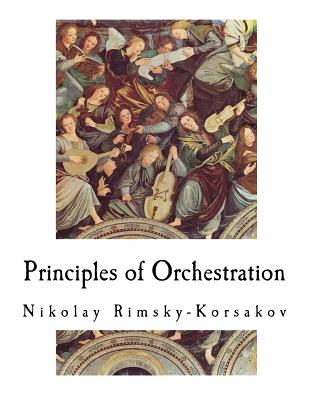
Principles of Orchestration
Paperback
Series: Principles of Orchestration, Book 1
Music CompositionConductingGeneral World History
ISBN13: 9781720953524
Publisher: Createspace
Published: Jun 9 2018
Pages: 166
Weight: 0.88
Height: 0.35 Width: 8.50 Depth: 11.02
Language: English
Also in
Music Composition
Music Theory Note by Note: Your Guide to How Music Works--From Notes and Rhythms to Complete Compositions
Miller, Michael
Paperback
The Technique of Choral Writing: A Comprehensive Guide to Composing and Arranging for Vocal Ensembles
Nielsen, Matthew D.
Hardcover
Music Production For Beginners 2020 Edition: How to Produce Music, The Easy to Read Guide for Music Producers
Swindali, Tommy
Hardcover
Manuscript Book Large Staves: Great Music Writing Notebook Wide Staff, Blank Sheet Music Notebook!
Helj, Mirela
Paperback
Robert Schumann's Leipzig Chamber Works: Music in the Great Stream of Time
Hedges Brown, Julie
Hardcover
Music Theory Staff Paper: Manuscript Paper with Keyboard Layout and Space for Note-Taking
Roberson, Malia Jade
Paperback
Max/Msp/Jitter for Music: A Practical Guide to Developing Interactive Music Systems for Education and More
Manzo, V. J.
Paperback
Genesis of a Music: An Account of a Creative Work, Its Roots, and Its Fulfillments, Second Edition
Partch, Harry
Paperback
The Mind's Ear: Exercises for Improving the Musical Imagination for Performers, Composers, and Listeners
Adolphe, Bruce
Paperback
Creative Orchestration: A Project Method For Classes In Orchestration And Instrumentation
McKay, George Frederick
Paperback
Creating Sounds from Scratch: A Practical Guide to Music Synthesis for Producers and Composers
Pejrolo, Andrea
Metcalfe, Scott B.
Paperback
Professional Orchestration Vol 1: Solo Instruments & Instrumentation Notes
Alexander, Peter Lawrence
Paperback
Atonal Improvisation and Jazz: A study of Chromatic Interval Pairs and Trichords
Davis, Jared E.
Paperback
The Art of Sampling: The Sampling Tradition of Hip Hop/Rap Music and Copyright Law
Said, Amir
Paperback
Principles of Orchestration: The Age of Brilliance and Imaginative Quality
Rimsky-Korsakov, Nikolay
Paperback
Electronic Dance Music Production: The Advanced Guide On How to Produce Music for EDM Producers
Swindali, Tommy
Paperback
Shortcuts to Hit Songwriting: 126 Proven Techniques for Writing Songs That Sell
Frederick, Robin
Paperback
Working as a Film Composer: The Art and Business of Composing for Film, TV and Games
Brown, Bill
Hardcover
Building Bridges with Music: Stories from a Composer's Life -- Expanded Second Edition
Adler, Samuel
Paperback
Music Production For Beginners 2020 Edition: How to Produce Music, The Easy to Read Guide for Music Producers
Swindali, Tommy
Paperback
How to Read Music for Any Instrument: Daily Exercises to Understand Music in 21 Days
Press, Barton
Paperback
Instrumental Music Education: Teaching with the Musical and Practical in Harmony
Feldman, Evan
Contzius, Ari
Paperback
How to Write for Percussion: A Comprehensive Guide to Percussion Composition
Solomon, Samuel Z.
Paperback
How to Write a Song (Even If You've Never Written One Before and You Think You Suck)
Bell, Ed
Paperback
Mozart Wolfang Amadeus - Piano Sonatas - Sheet Music - Volume 1: Numbers: 1°2°3°4°5°6°7°8°9°
Mozart, Wolfang Amadeus
Paperback
Music Theory Essentials: A Step-by-Step Introduction to Music Theory for All Musicians
Press, Barton
Paperback
Choral Composition: A Handbook for Composers, Arrangers, Conductors, and Singers
Hines, Robert Stephan
Hardcover
Singing for People with Parkinson's: Designing and delivering singing sessions for people with Parkinson's and other degenerative neurological disorde
Hancox, Grenville
Wydenbach, Nicola
Vella-Burrows, Trish
Paperback
Guitar Sheets Collection: Over 200 pages of Blank TAB Paper, Staff Paper, Chord Chart Paper, Scale Chart Paper, & More
Triola, Christian J.
Paperback
Maqam Melodies: Pitches, Patterns, and Developments of Music in the Middle East and Other Microtonal Writings
Thoegersen, Peter
Hardcover
Music Manuscript Book (Purple): 96 pages, 12 staves: Includes Music Reference Charts
Publishing, Em Music
Paperback
Working as a Film Composer: The Art and Business of Composing for Film, TV and Games
Brown, Bill
Paperback
The Wound That Will Never Heal: An Allegorical Interpretation of Richard Wagner's the Ring of the Nibelung
Heise, Paul Brian
Paperback
Elliott Carter: Collected Essays and Lectures, 1937-1995
Carter, Elliott
Bernard, Jonathan W.
Paperback
The 30-Day Speed Songwriting Challenge: Banish Writer's Block for Good in Only 30 Days
Bell, Ed
Paperback
The 30-Day Lyric Writing Challenge: Transform Your Lyric Writing Skills in Only 30 Days
Bell, Ed
Paperback
Mr. Martie's Marvellous Melodies - Book 1: A Kids Learn and Play Guitar Songbook
Cast, Martyn
Paperback
Manuscript Book Medium Staves: Great Music Writing Notebook Medium Staff, Blank Sheet Music Notebook!
Helj, Mirela
Paperback
Professional Orchestration Vol 2A: Orchestrating the Melody Within the String Section
Alexander, Peter Lawrence
Paperback
Guitar Sheets TAB Paper: Over 100 pages of Blank Tablature Paper, TAB + Staff Paper, & More
Triola, Christian J.
Paperback
Piano Songs for Advanced Beginners: The Best Classical Pieces Color-Coded + Audio
Hermann, Damian
Paperback
The Theory and Creation of Music: A Comprehensive Guide to Composing Your Own Music
Taylor, Ryan
Hardcover
Sergei Rachmaninoff: 6 Moments Musicals Op.16 3 Bonus: Variations on a Theme of Chopin Op.22 Prelude
Rachmaninoff, Segei
Paperback
Ukulele: The Ultimate Guide to Mastering Ukulele for Beginners in 30 Minutes or Less!
Forbes, Christina
Paperback
HowExpert Guide to Playing Guitar: 101+ Tips to Choosing, Maintaining, and Learning How to Play the Guitar for Beginners
Fernandez, Norm
Howexpert
Paperback
The Elements of Song Craft: The Contemporary Songwriter's Usage Guide To Writing Songs That Last
Seidman, Billy
Paperback
Fresh Music: Explorations with the Creative Workshop Ensemble for Musicians, Artists, and Teachers
Damian, Jon
Paperback
Composition Notebook: College Ruled Lined Paper Composition Notebook for Journal, College, School, Work
Tatum, Brooke
Paperback
Professional Orchestration Vol 2B: Orchestrating the Melody Within the Woodwinds & Brass
Alexander, Peter Lawrence
Paperback
The Solfeggio Tradition: A Forgotten Art of Melody in the Long Eighteenth Century
Baragwanath, Nicholas
Hardcover
Guitar Sheets Songwriting Journal: Over 100 Pages of Blank Lyric Paper, Staff Paper, TAB Paper, & more
Triola, Christian J.
Paperback
Sheet Music for Classical Piano: Bach, Mozart, Beethoven and Their Masterpieces A Journey Through the Works of the Three Giant and Most Celebrated Cla
Beethoven, Ludwig Van
Bach, Joann Sebastian
Mozart, Wolfgang Amadeus
Paperback
The Practice of Popular Music: Understanding Harmony, Rhythm, Melody, and Form in Commercial Songwriting
de Clercq, Trevor
Paperback


 Sign-In
Sign-In Cart
Cart